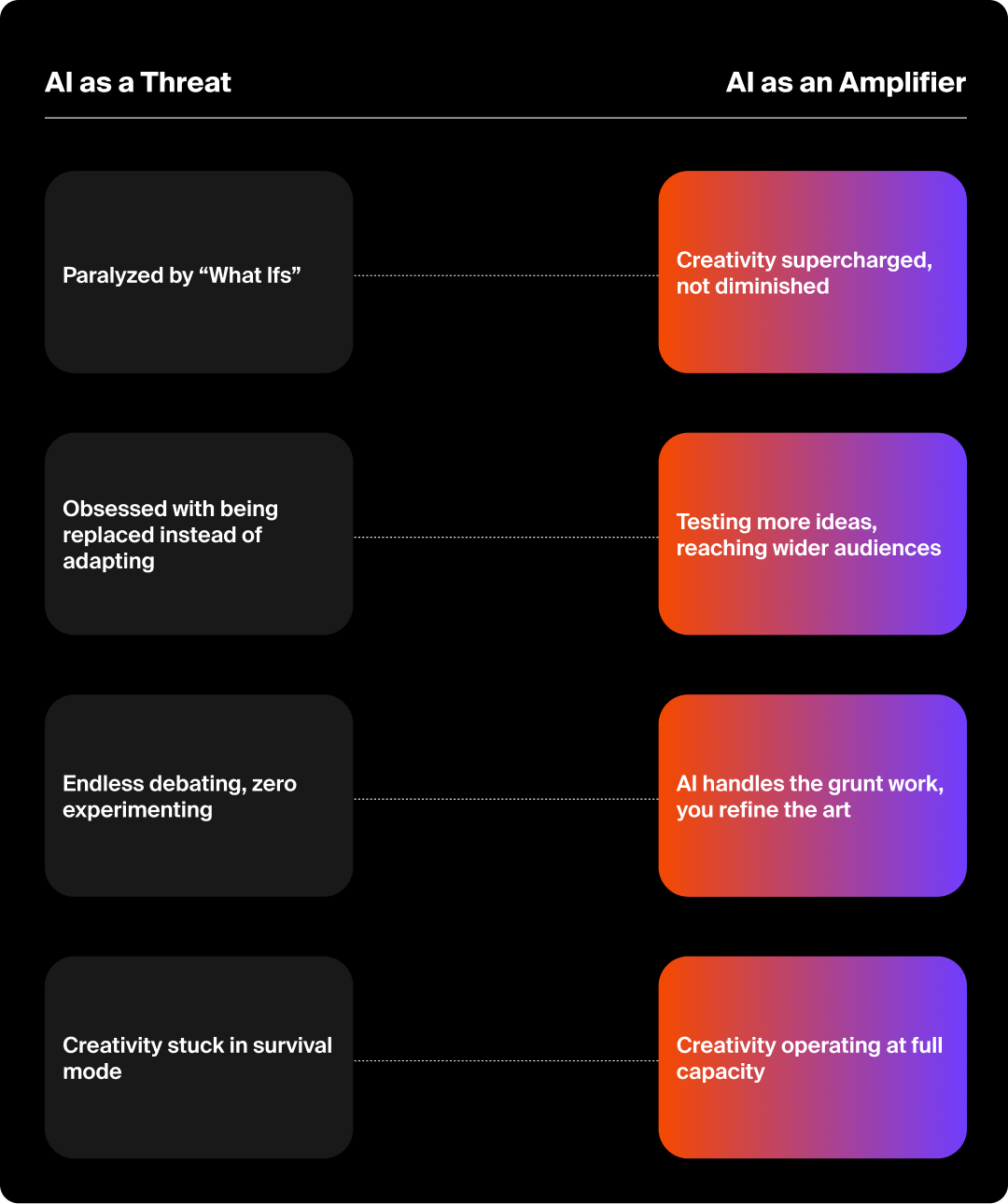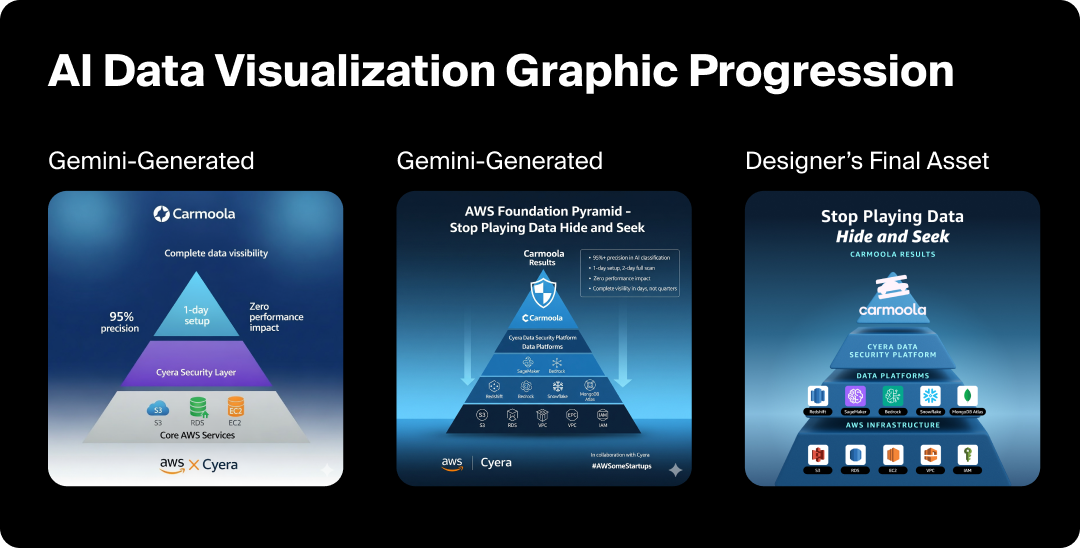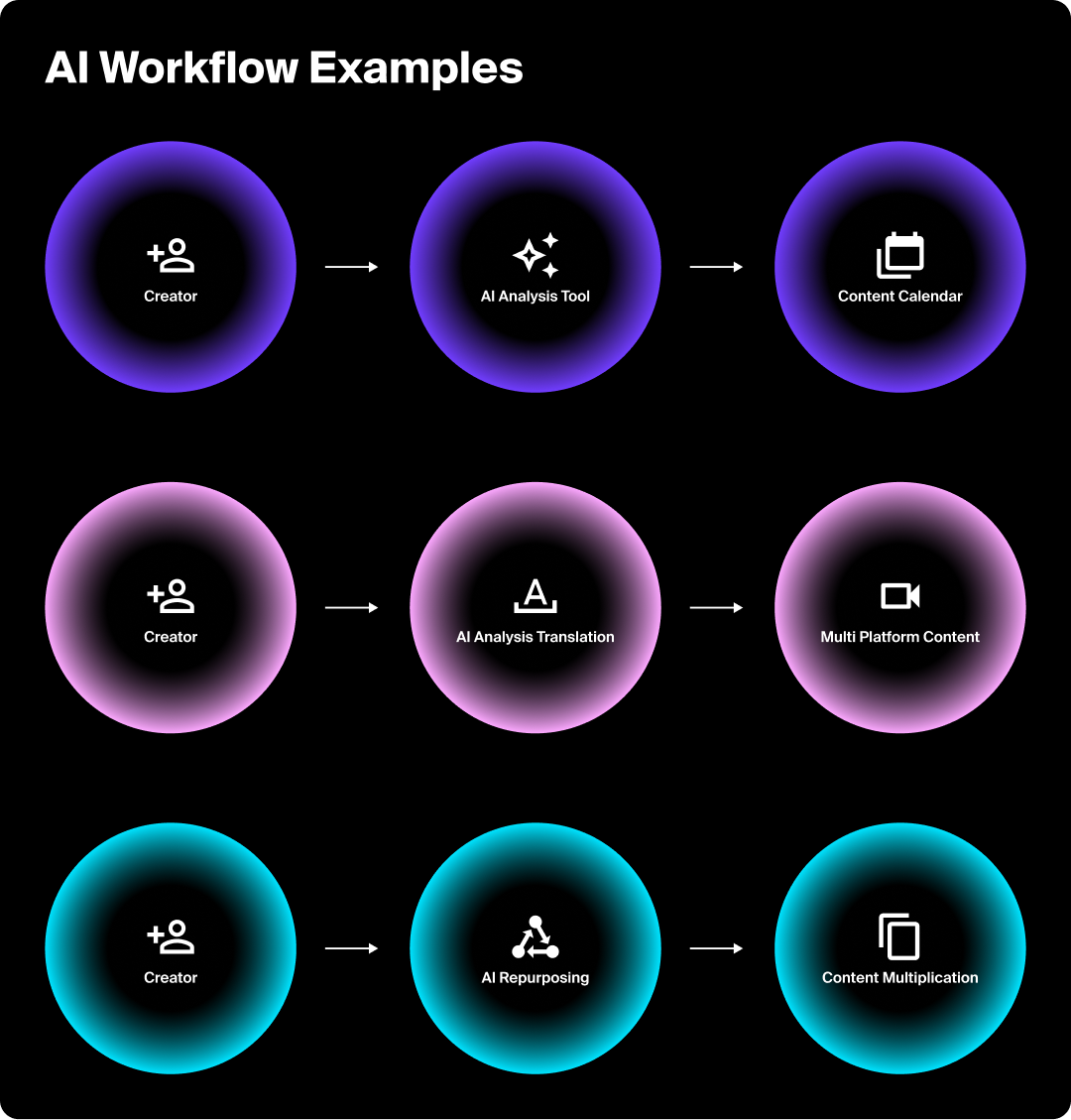The creative and social media community is having an identity crisis, and AI is at the center of it.
Scroll through any creator forum, design Discord, or marketing LinkedIn thread, and you’ll find the same anxiety playing out: Will AI make me irrelevant? Should I be using these tools for every task? If I do, am I selling out my creativity?
The reality check is this: while you’re debating whether to use AI, your competitors are already three steps ahead, cranking out more content, testing more ideas, and reaching more audiences than ever before. They’re not replacing their creativity with AI, they’re amplifying it. In fact, only about 40% of creators use AI throughout their entire workflow, which means the majority are still leaving efficiency gains on the table.
Everyone’s dancing around the surface-level fear of AI taking over, but that’s the wrong conversation entirely. While creators are stuck arguing about whether AI will replace them, the real question has already shifted to implementation. The creators who are winning aren’t wasting time on philosophical debates, they’re deep in the weeds figuring out which tools work, how to prompt effectively, and where AI fits into their creative process. The question isn’t whether AI will change content creation; it already has. The question is whether you’ll learn to wield it or watch others master what you’re still afraid to touch.
This isn’t another “AI is coming for your job” scare piece. This is a mindset reset for creators who want to stay relevant, efficient, and authentically creative in an AI-powered world. Because here’s what the fear-mongerers aren’t telling you: the most successful creators aren’t being replaced by AI. They’re using AI to become irreplaceable.
Mindset Shift #1: “AI doesn’t diminish your creativity, it multiplies your creative capacity. Think of it as having a tireless creative partner who never gets writer’s block.”

From ideation that breaks through creative blocks, to automation that handles the grunt work, AI is becoming the ultimate creative catalyst. The brands and creators winning right now aren’t the ones with the biggest budgets or the most followers, they’re the ones who understand how to blend human intuition with artificial intelligence.
Whether you’re a solo creator juggling five different content pillars, a startup trying to compete with enterprise-level output, or an established brand looking to stay culturally relevant, this guide will show you how to leverage AI without losing what makes your voice unique. We’ll explore which tools actually move the needle, how to generate content ideas that feel authentic rather than algorithmic, and why the future belongs to creators who master the art of human-AI collaboration.
AI isn’t going anywhere. Neither should your creativity. The time to figure out how they work together is now.
Where to Actually Plug AI Into Your Content Workflow
Every creator’s workflow has bottlenecks. The smart creators are those identifying exactly where AI can eliminate friction without disrupting what makes their content their own.
Current Applications Across the Creative Spectrum
Pre-Production: Research & Ideation Phase
This is where I truly believe AI is the most helpful. Plug it in when you’re staring at a blank content calendar or trying to understand what your audience actually wants. Use AI to analyze competitor content, identify trending topics in your niche, and generate 50+ content ideas in minutes.
The key: feed it your existing top-performing content so it learns your style, then let it suggest variations and angles you hadn’t considered.
Mindset Shift #2: “Your creative instincts aren’t being replaced by data, they’re being informed by it. AI handles the research; you make the creative leaps.”
Content Creation: Polish Without the Perfectionism
AI is handling the tedious editing work that used to eat up hours. Grammar checks, tone adjustments, readability improvements: all automated. Tools like Grammarly AI and Jasper are letting creators focus on the big picture while AI sweats the small stuff.
For visual creators, AI can generate rough drafts of graphics, wireframes, and even basic animation sequences that you can refine with your creative vision.
The sweet spot: use AI to get 70% of the way there, then apply your unique eye and expertise for the final 30%. This keeps your ownership intact while cutting creation time in half.

Visual Production: From Concept to Creation
Designers are using Midjourney and DALL-E to generate mood boards, create placeholder graphics, and even produce final assets. Photo editors are letting AI remove backgrounds, enhance lighting, and generate product shots. AI tools are able to jump in and expand what’s possible when you’re working with tight budgets and tighter deadlines.
Content Optimization: Goodbye to the Overwhelm
AI is analyzing audience behavior, suggesting optimal posting times, and generating hashtag strategies based on actual performance data. It’s social listening on steroids, giving creators insights they’d never have time to gather manually.
But the real power is in content transformation: take a verbal script from a keynote presentation and turn it into a data viz graphic for Linkedin, convert podcast insights into Twitter thread formats, or transform video tutorials into step-by-step carousel posts. The content strategy gets smarter, not more robotic.
Post-Production: Analysis & Iteration
Implement AI for performance analysis and audience feedback synthesis. Let it analyze comments to identify content gaps, track which topics resonate most, and suggest content iterations based on performance data. Use these insights to inform your next content cycle rather than guessing what worked.
Administrative Tasks: The Background Operations
Deploy AI for scheduling optimization, hashtag research, and basic social media management. These are the tasks that drain creative energy without adding creative value. Automate them completely so your brain stays focused on strategy and storytelling.
Creator AI Use Cases
Imagine a creator with millions of followers using AI to analyze their comment sections and identify trending topics their audience actually cares about, then weaving those insights into content planning. This kind of AI-driven optimization could result in significantly higher engagement rates because they’d be speaking to proven audience interests instead of guessing.

Picture a fitness creator using AI to batch-process workout descriptions across multiple languages and platforms, scaling content to international audiences without hiring a translation team. Content output could triple while maintaining their signature tone.
Or consider a B2B creator leveraging AI to repurpose newsletter content into LinkedIn posts, Twitter threads, and course materials, turning one piece of content into 10+ touchpoints. Time spent on content creation could drop, while reach expands across platforms.
These scenarios aren’t far-fetched. This is exactly how forward-thinking creators are deploying AI right now. The pattern points to AI being used as a creative amplifier; not as a shortcut, not as a crutch. It’s a tool that clears the clutter so creators can double down on what truly moves the needle: strategy, distinct voice, and genuine human connection.
What Is the Best AI to Use for Content Creation?
Today, there isn’t a single AI tool that can do it all; and that’s a good thing. The sheer volume of tools being released suggests the field is fragmented: many tools specialize in one or a few tasks, whether it’s video editing, voice generation, design, or ideation. Each tool has its strengths, and creative professionals who want to expedite their success will learn how to combine them. The real opportunity is learning which tool to deploy, and when.
Avoid using AI to speed up what you’re already good at. Deploy strategically to shore up your weak spots. The goal isn’t to drop everything and let AI take over, it’s to use AI as your creative support system where you need it most.
The Creator’s AI Workflow: Tools by Content Type & Process Stage
Writing & Copy Creation
Blog Posts & Long-Form Content:
- ChatGPT: Conversational tone, research assistance
- Claude: Detailed analysis, structured content
- Jasper: Brand voice consistency, marketing copy
- Grammarly AI: Grammar, tone, and clarity optimization
Social Media Copy:
- Copy.ai: Short-form social captions and ads
- Lately: Repurposing long content into social snippets
- Hootsuite AI: Platform-optimized captions and hashtags
Visual Content Creation
Photography & Human Images:
- Midjourney: Photorealistic human portraits and lifestyle shots
- DALL-E 3: Consistent character generation across posts
- Stable Diffusion: Fine-tuned control for specific brand aesthetics
- Photoshop AI (Adobe Firefly): Photo enhancement and background removal
- Facetune AI: Portrait retouching and enhancement
Brand Graphics & Design:
- Canva AI: Template-based design with smart suggestions
- Adobe Express: Quick social graphics with brand consistency
- Figma AI: Design system integration and component generation
- Looka: Logo and brand identity creation
Data Visualization:
- Tableau AI: Advanced chart creation and data insights
- Beautiful.ai: AI-powered presentation design
- Gamma: Data-driven slide generation
- ChartGPT: Quick chart creation from raw data
- Polymer: Automated dashboard creation
Video & Animation Content
Video Production:
- Runway ML: AI video generation and editing
- Synthesia: AI avatar creation for talking head videos
- Luma AI: 3D scene generation and product showcases
- Descript: AI-powered video editing and transcription
- Pictory: Text-to-video conversion for social content
Animation & Motion Graphics:
- LottieFiles AI: Micro-animations for social media
- Steve AI: Animated explainer video creation
- Animoto: Template-based video creation with AI optimization
- Vyond: Character animation for educational content
Audio Content Creation
Podcasting & Voice Content:
- ElevenLabs: AI voice generation and cloning
- Murf: Professional voiceovers for videos
- Descript: Audio editing and transcription
- Riverside.fm AI: Podcast post-production automation
Music & Sound:
- AIVA: Background music composition
- Boomy: Quick music generation for content
- Soundraw: Customizable royalty-free music creation
Platform-Specific AI Integration
Instagram:
- Native AI features: Reels editing, story templates
- Third-party: Later AI for optimal posting times
TikTok:
- Native AI features: Video effects, trending sound recommendations
- Third-party: CapCut for AI-powered video editing in a TikTok format
LinkedIn:
- Native AI features: Post optimization suggestions
- Third-party: Jasper for professional tone (ex. for B2B content)
YouTube:
- Third-party: TubeBuddy AI for thumbnail testing and YouTube SEO, VidIQ for AI-powered analytics and content suggestions
The Strategic AI Tool Selection Framework
With hundreds of AI tools to choose from and more on the way, the decision paralysis might be setting in. Here’s how to cut through the noise and build a toolkit that actually works:

- Content Type: Match tools to your primary content format. Start with what you create most. Video creators should prioritize editing and production tools before diving into copywriting AI. Writers need solid text generation and editing tools before exploring image creation. Master your core content type, then expand.
- Brand Consistency: Choose tools that can learn and maintain your voice. Look for tools that can be trained on your existing content or allow custom style guides. Generic output kills authenticity. The best AI tools for creators are the ones that can adapt to your specific tone, not force you into theirs.
- Workflow Integration: Prioritize tools that work together seamlessly to avoid the copy-paste nightmare. Choose tools that can export to formats your other tools accept, or better yet, integrate directly with your existing workflow. If you’re constantly reformatting AI output, you’re working against the efficiency gains.
- Learning Curve vs. Output Quality: Balance ease of use with creative control. Some tools are powerful but complex. Others are simple but limited. Map this to your timeline: if you need results tomorrow, go simple. If you’re building long-term capability, invest time in learning more sophisticated tools.
- Budget Allocation: Mix of premium tools for core needs, free tools for experimentation. Pay for what you use daily. Experiment with free versions for everything else. Most creators need 2-3 paid tools maximum; the rest should be free trials and freemium options until they prove their worth in your workflow.
Mindset Shift Callout #3: Don’t chase every new AI tool. Master the ones that align with your creative vision and enhance your unique strengths as a creator.
How to Use AI to Generate Content Ideas
Start Feeding AI Context, Not Requesting Ideas
The anatomy of effective AI prompts starts with context, not requests. Instead of asking for ideas, feed AI your top-performing content, your audience demographics, recent engagement patterns, and specific challenges you’re facing. Then ask for solutions as content, not suggestions.
Use AI to analyze what’s actually trending in your space: conversation themes, pain points showing up in comments, and gaps where your competitors are staying silent. AI can process thousands of social posts to identify patterns you’d never catch manually.

For seasonal and timely content, AI excels at connecting your niche to broader cultural moments. It can spot opportunities where your expertise naturally fits into trending conversations, helping you join discussions authentically rather than force relevance.
The Human-AI Collaboration Process
Research Phase: AI for Market Analysis & Trend Identification
Let AI handle the data heavy lifting: competitor analysis, audience pain point identification, target audience desires, and emerging trend spotting. AI processes information faster than you can scroll, giving you insights to build on.
Ideation Phase: Using AI as a Brainstorming Partner
Present AI with your research findings and ask it to generate angles that connect your unique perspective to audience needs. You’re not asking for random ideas, you’re asking for strategic bridges between what you know and what your audience wants.
Refinement Phase: Human Curation & Brand Alignment
AI generates volume; you provide vision and direction. Filter raw ideas through your brand values, content goals, and authentic voice. This is where human curation separates good creators from algorithmic content farms.
Execution Phase: AI-Assisted Content Creation & Optimization
Once you’ve selected ideas, use AI to optimize content structures and identify cross-platform opportunities. The concept is yours, but AI enhances the execution.
Mindset Shift Callout #4: The magic happens in the collaboration, not the automation. You bring the vision, context, and emotional intelligence; AI brings the processing power and endless iteration capability.
Let AI Architect Content Pillars
Use AI to develop content pillars that align with your brand’s core values, business goals, and unique strengths. Feed AI your brand positioning, target KPIs, solutions you offer, and competitive advantages, then ask the agent to suggest content themes that ladder up to these strategic priorities.
AI can help you balance product educational content with trending community content by analyzing when each type advances your goals while staying culturally relevant. The result is content pillars that are both data-informed, and authentically aligned with what your project actually stands for.
Practical Frameworks
The “AI + Personal Experience” Formula: Start with AI-identified trends or audience questions, then layer your personal experience or brand perspective into the fold.
Content Repurposing: Use AI to transform one core piece across multiple formats and platforms without starting from scratch.
Community-Driven Ideation: Feed AI your audience’s comments and feedback to identify recurring themes and let their actual language guide what you create next.
Mindset Shift Callout #5: Your lived experiences, cultural perspective, and personal insights are irreplaceable assets that AI can help you communicate more effectively, not replace.
Will AI Replace Content Creators?
The short answer: no.
The longer answer: creators who refuse to adapt will replace themselves.
Irreplaceable Human Elements
AI can generate text, images, and even videos, but it can’t replicate the human experiences that make content truly compelling. Your messy breakup, career pivot, or cultural background aren’t in any training dataset. Neither is your ability to read a room, sense when your community needs support versus motivation, or know when to break your own content rules because the moment calls for it.
Emotional intelligence drives the decisions that separate memorable content from forgettable noise. AI doesn’t understand when to be vulnerable, when to challenge your audience, or when to stay silent during cultural moments. It can’t build genuine relationships or navigate the complex social dynamics that turn followers into communities.
Brand authenticity isn’t just tone consistency, it’s the accumulation of choices, mistakes, and growth that audiences connect with over time. Cultural nuance and context understanding require lived experience that no algorithm can simulate.
The Future of AI-Human Creative Partnership
The content creators and social media professionals thriving aren’t the ones with the most followers or biggest budgets. They’re the ones treating AI as their ultimate creative assistant: a workforce handling research, first drafts, and optimization while they focus on strategy, relationships, and authentic storytelling.
Smart creators are positioning themselves as curators and strategists. They’re developing skills that become more valuable when AI handles the execution: conceptual thinking, audience psychology, cultural interpretation, and creative direction. The ability to prompt AI effectively is becoming as important as traditional creative skills.
“AI-native” creators are emerging by not using AI to replace their creativity; they’re using it to scale their creative capacity.
Mindset Shift Callout #6: The future belongs to creators who can seamlessly blend human intuition with AI efficiency. You’re not competing against AI, you’re learning to dance with it.
Market Reality Check
Despite the hype around it, AI still struggles with creative nuance and cultural context. Audiences can spot AI-generated content from a mile away; it often feels hollow, generic, or slightly “off” in ways that trigger our instinctive preference for threads of humanity.
The uncanny valley effect is real: content that’s almost human (but not quite) creates an uncomfortable disconnect that makes people scroll past rather than engage. This is why fully AI-generated content rarely goes viral or builds genuine community. It lacks the imperfections, personality quirks, and lived experiences that audiences crave to consume.
Embracing the AI-Augmented Creative Future
AI is not the enemy of your creativity; it’s the amplifier your creative process has been waiting for. Start small: choose one tool that solves your biggest workflow bottleneck and master it before moving on. Your human touch remains your greatest asset; AI simply helps you communicate your ideas more effectively and reach more people.

Debating whether AI is good or bad is wasted energy. It’s here, and it will only become more embedded in every part of our work and lives. The key mindset shift is this: learn to control AI before it controls you.
Join it, shape it, and use it to build the creative career you actually love, and thrive in.





